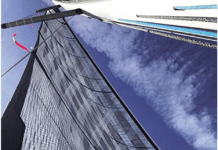Tartan 27
The Tartan 27 went into production in 1961 with fiberglass boatbuilding in its toddler stage; production ceased in 1980, after 19 years interrupted only by a fire in 1972 that resulted in no 27s being built that year. The greatest number of 27s built in one year is 85; the year was 1964. In all, 712 Tartan 27s were built, including a dozen boats under license in California. Remarkably few significant changes were made to the boat until near the end of the long production run, after hull #650.
Tartan 33
In 1978, Tartan brought out the Tartan Ten, a 33', fairly light, fractionally-rigged "offshore one design." The boat was a huge success: fast, easy to sail, and unencumbered by the design limitations of a rating rule. But the Tartan Ten had one big problem: limited accommodations with stooping headroom, an interior most kindly described as spartan. A hardy crew could take the Tartan Ten on a multi-day race such as the Mackinac, and you might even coax your family aboard for a weekend of camping out. But cruising or extended racing in comfort? Forget it!
Tartan 34
More than 500 Tartan 34s were built between 1968 and 1978. By 1978 the CCA rule was long gone, PHRF racing was beginning to surge, and the MHS (now IMS) was in its infancy. The Tartan 34 had passed from a racer/cruiser to a cruiser, not because the boat had changed, but because sailboat racing had changed. The Tartan 34 was succeeded by the larger, more modern Tartan 37, a boat of exactly the same concept.
Catalina 27
The Catalina 27 has been in production since 1971, and well over 6,000 of them have been built. This is undoubtedly the largest production run of any 27' sailboat in US history, and probably the biggest anywhere. The flip side of the coin is that Catalinas are known as cheaply built boats, with lots of corners cut in places they shouldn't be cut.









































